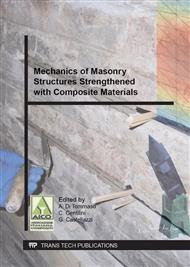[1]
A. Viskovic, F. Fumagalli, Composite Reinforcements with Inorganic Matrices for Masonry Structures, V International Seminar Structural Analysis of Historical Construction, SAHC06, New Delhi, India, November 6-8, (2006).
Google Scholar
[2]
A. Viskovic, F. Fumagalli, Composite reinforcement with inorganic matrices – Part I: Masonry walls with composite reinforcement in the mortar plaster, International Conference Protection of Historical Buildings, PROHITECH 09, Rome, Italy, June 21-24, (2009).
Google Scholar
[3]
J. Kubica, A. Kwiecień, B. Zając, Repair and strengthening by use of superficial fixed laminates of cracked masonry walls sheared horizontally – laboratory tests, Seismic Engineering International Conference MERCEA'08, Villa San Giovanni Reggio Calabria 2008. American Institute of Physics, AIP Conf. Proc. 1020, 1546 (2008).
DOI: 10.1063/1.2963782
Google Scholar
[4]
A. Kwiecień, Polymer flexible joints – innovative method of repair and conservation of heritage objects. Wiadomości Konserwatorskie 26/2009, pp.234-244.
Google Scholar
[5]
A. Kwiecień, Highly deformable polymers for repair and strengthening of cracked masonry structures. GSTF International Journal of Engineering Technology (JET) Vol. 2 No. 1, May 2013, pp.182-196.
DOI: 10.5176/2251-3701_2.1.53
Google Scholar
[6]
M.R. Valluzzi, D. Oliveira, A. Caratelli, G. Castori, M. Corradi, G. de Felice, E. Garbin, D. Garcia, L. Garmendia, E. Grande, U. Ianniruberto, A. Kwiecień, M. Leone, G.P. Lignola, P.B. Lourenço, M. Malena, F. Micelli, M. Panizza, C.G. Papanicolaou, A. Prota, E. Sacco, T.C. Triantafillou, A. Viskovic, B. Zając, G. Zuccarino, Round Robin Test for Composite-To-Brick Shear Bond Characterization, Materials and Structures, 45 (2012).
DOI: 10.1617/s11527-012-9883-5
Google Scholar
[7]
M. Malena, G. de Felice, Debonding of composites on a curved masonry substrate: Experimental results and analytical formulation. Composite Structures 112 (2014), 194-206.
DOI: 10.1016/j.compstruct.2014.02.004
Google Scholar
[8]
A. Kwiecień, Stiff and flexible adhesives bonding CFRP to masonry substrates - investigated in pull-off test and Single-Lap test. Archives of Civil and Mechanical Engineering 12 (2) 2012, Elsevier, p.228–239.
DOI: 10.1016/j.acme.2012.03.015
Google Scholar
[9]
T. Falborski, A. Kwiecień, Ł. Piszczyk, M. Strankowski, R. Jankowski, The influence of temperature on properties of the polymer flexible joint used for strengthening historical masonries. Structural Analysis of Historical Constructions – Jerzy Jasieńko (ed), 2012 DWE Wrocław, Poland, pp.816-822.
Google Scholar
[10]
A. Kwiecień, B. Zając, Energy approach in analysis of masonry columns confined with GFRP mesh bonded on stiff and flexible adhesives. Structural Analysis of Historical Constructions – Jerzy Jasieńko (ed), 2012 DWE Wrocław, Poland, pp.1864-1872.
Google Scholar
[11]
G. Croci, A. Viskovic, The use of aramidic fibers in the restoration of the Basilica of St. Francis of Assisi, Conference STREMAH99, Dresda, Germany, June 22-24, (1999).
Google Scholar


